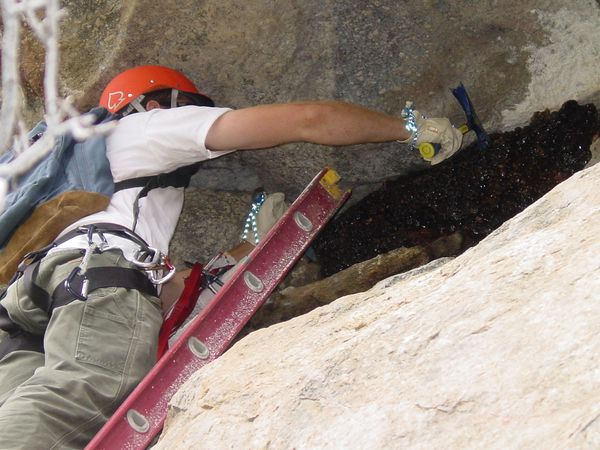Single-leaf pinyon pine is a surprisingly recent arrival at the Reserve and neighboring mountains. Our tour guide to this transition is the humble packrat (Neotoma). Before there were field botanists there were packrats. A packrat industriously gathers, hauls and piles snippets and bits of everything it finds within a few hundred feet of its, well, “rat’s nest”. If protected in a dry rock alcove or cave, the urine-soaked refuse heaps (middens) become a hardened time capsule of local vegetation and other objects (e.g. small bones, teeth, beetles), all awaiting a paleo-ecologist.
At City of Rocks, Dr. Julio Betancourt and colleagues found and recovered ancient pack rat middens from grottoes and deep joints in the granitic formations. Aided by radiocarbon dating of these long-past nests, they proved that limber pine has been retreating uphill during the late Holocene. Younger, lower elevation middens lacked its needles, and in their place there appeared the needles of single-leaf pinyon pine, Pinus monophylla. At City of Rocks, this pinyon’s distinctive needles first appear in a 2500-year-old midden. Twelve centuries later, it formed the forests mixed with Utah and Rocky Mountain juniper that persist there to this day. To put 1300 AD in more familiar historical perspective, at that time, ancestral Puebloan peoples were abandoning their Mesa Verde cliff dwellings, Kublai Khan was forming the Yang Dynasty in China, the Ottoman Empire arose, and Notre Dame cathedral was new. Ruins of civilizations past are nothing new to us, but to stand amid trees of a forest type that has been, and still is, on the move is to experience recent ecological time.
Since the end of the last Ice Age, single-leaf pinyon has been spreading northward from its refugia in the southern Sierra Nevada and adjacent NW Arizona. How did wingless pine seeds travel so far? They flew in the gullets of pinyon jays, who stash great troves of them for dining in later months. The small forests of this pinyon growing at City of Rocks represent the species’ newest, northernmost outpost. Their northward progression will soon be stopped at the margin of the treeless Snake River Plain, the end of a grand biogeographic trip. Here then is an unusual opportunity to encounter natural, climatically-driven range expansion of a plant species, an experience that will be novel for most Reserve visitors.



